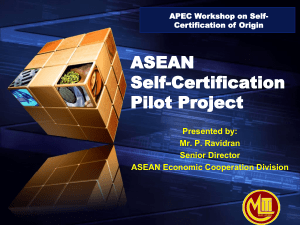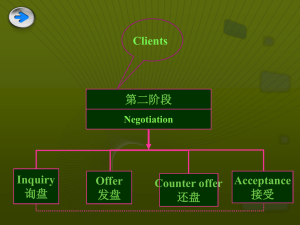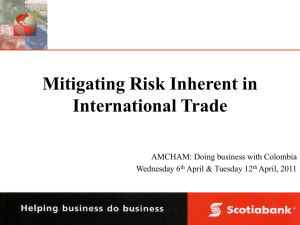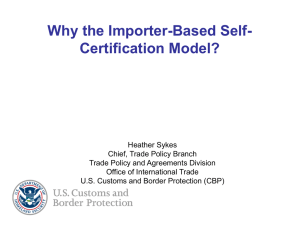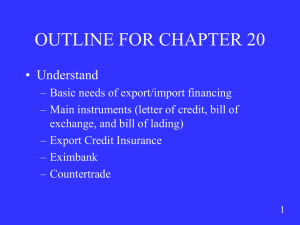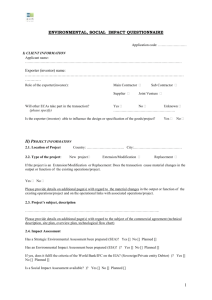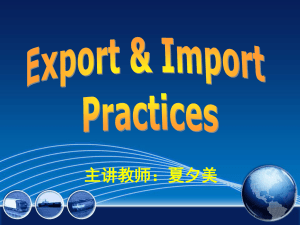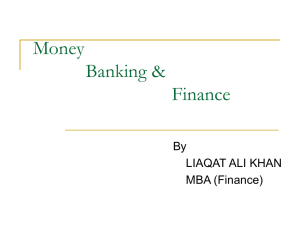ASEAN Self Certification System
advertisement
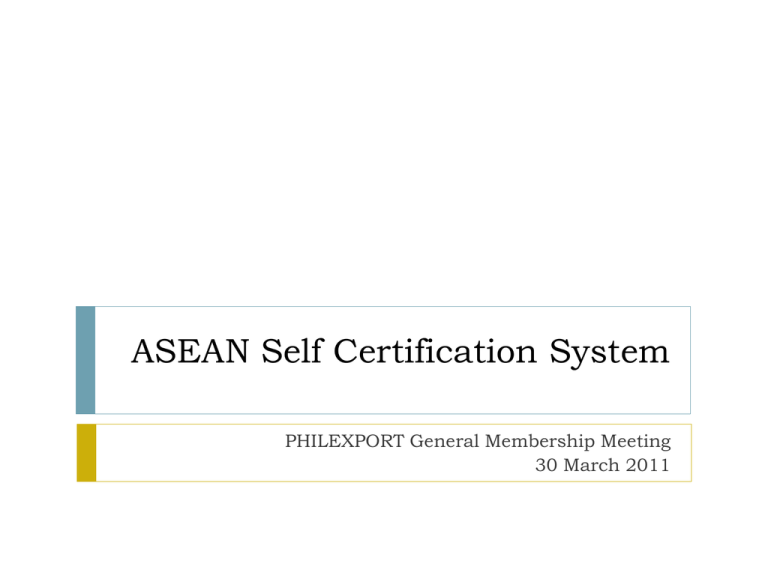
ASEAN Self Certification System PHILEXPORT General Membership Meeting 30 March 2011 Background Mandate from the AFTA Council Facilitation of trade towards the realization of AEC in 2015 Overview of ASEAN Dual Certification Regime Approach Conventional System Self Certification by Certified Exporters DUAL CERTIFICATION PROCEDURE: CONVENTIONAL vs. SELF-CERTIFICATION Step 1: APPLICATION FOR PRE-EXPORT VERIFICATION Step 2: PRE-EXPORT VERIFICATION Step 3: CO APPLICATION Step 4: EXAMINATION & ISSUANCE OF CO MANUFACTURER / EXPORTER Applies for the pre-export verification of the origin of goods ISSUING AUTHORITY / BODY Conducts the pre-export examination. Step 2: EXAMINATION & AUTHORIZATION AS “CERTIFIED EXPORTER” MANUFACTURER / EXPORTER Applies for a CO. Submits the result of pre-export verification and appropriate requirements. Step 3: SELF DECLARATION ON THE ORIGIN OF THE PRODUCT ISSUING AUTHORITY / BODY Issues the CO. Retains duplicate copy of the CO. Step 4: PRESENTATION OF THE INVOICE DECLARATION MANUFACTURER / EXPORTER Sends original CO to the IMPORTER. Retains the triplicate copy of the CO. Step 5: PRESENTATION OF THE CO Step 1: APPLICATION FOR “CERTIFIED EXPORTER” IMPORTER Submits the CO to CUSTOMS at the time of import declaration to claim preferential treatment. MANUFACTURER / EXPORTER Applies for “Certified Exporter” status and provides necessary guarantees. ISSUING AUTHORITY / BODY Conducts appropriate examination and authorizes exporter to make out invoice declarations. MANUFACTURER / EXPORTER Make out an invoice declaration on origin of the product then sends it to the IMPORTER IMPORTER Presents the invoice declaration to CUSTOMS at the time of import to claim preferential treatment. Work Plan on ASEAN Self Certification Stage l. Preparatory (to be competed by 2009) Stage ll. Development of Legal Provision/Instrument (to be competed by 2010) Stage lll. Implementation (to be completed by 2011) Stage l. Preparatory Knowledge enhancement Workshops, information sessions, experience sharing Information exchange between working groups Consultation (to be completed by Q3 2009) Private sector Relevant government agencies Relevant ASEAN working groups Research and capacity assessment Technical Assistance Stage ll. Development (to be completed by 2010) Crafting of legal instrument Bringing-in necessary provisions in the OCP Technical review and legal scrubbing by relevant bodies Testing the instruments via pilot project Stage lll. Implementation (to be completed by 2011) Development of materials for: Training the stakeholders Origin verification manual Development and implementation of communications strategy AMS to implement the self certification by 01 January 2012 Pilot Project Memorandum of Understanding (MOU) among the Participating ASEAN Member States was signed on 30 August 2010 and entered-into-force on 01 November 2010. Participating ASEAN Member States are: Brunei Darussalam Malaysia Singapore PILOT PROJECT ON SELF-CERTIFICATION STRUCTURE Step 1: APPLICATION FOR “CERTIFIED EXPORTER” MANUFACTURER / EXPORTER Applies for the pre-export verification of the origin of goods 1 2 Step 2: EXAMINATION & AUTHORIZATION AS “CERTIFIED EXPORTER” Step 3: SELF DECLARATION Step 4: PRESENTATION OF THE INVOICE DECLARATION COMPETENT AUTHORITY / BODY Evaluates exporters based on eligibility criteria 3 4 CERTFIED EXPORTER Make out an invoice declaration on origin of the product then sends it to the IMPORTER IMPORTER Presents the invoice declaration to CUSTOMS at the time of import to claim preferential treatment. 5 Application to Exporter/Manufacturer and Exporter/Trader. Applicants must prove the capability to correctly determine origin of the goods and maintain relevant records for verification. Minimum threshold value for “Certified Exporter” application Specific national “Certified Exporter” eligibility criteria in addition to minimum requirements applied ASEAN-wide Database of “Certified Exporters” Invoice Declaration “The exporter of the product(s) covered by this document (Certified Exporter No.......) declares that, except where otherwise clearly indicated, the products satisfy the Rules of Origin to be considered as ASEAN Originating Products under ATIGA (ASEAN Country of Origin: .............,) with origin criteria……” Way Forward Bringing in Self Certification in the ATIGA Review of existing legislations Institutional preparation for the certification process Awareness of the stakeholders Domestic implementation of the relevant ATIGA amendments. Thank you!!
